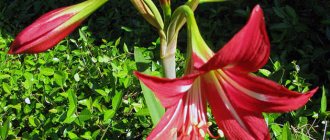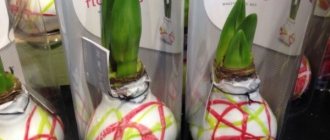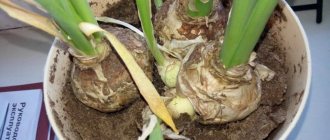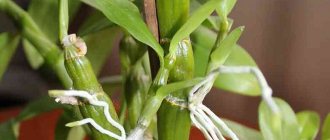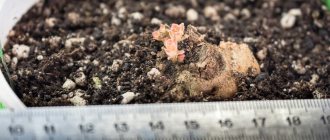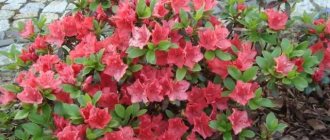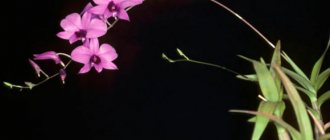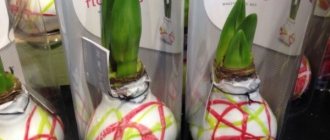Amaryllis care
Amaryllis is rightfully one of the most attractive house plants. It harmoniously combines the grace of leaves, the tenderness of inflorescences and a delicate aroma. At the same time, caring for the plant is so simple that even a novice gardener can grow an exotic guest from Africa.
Homeland and appearance of amaryllis
Amaryllis is native to South Africa. Very often amaryllis are confused with very similar plants - hippeastrum. However, amaryllis is much less common.
You can also add the following to the differences:
- Amaryllis has smaller inflorescences;
- Amaryllis blooms when the plant has leaves;
- Amaryllis can also be grown in open ground.
Amaryllis leaves are long, green, and shaped like a tongue. The length of the leaf plate reaches half a meter, the width is no more than 3 cm. On one plant, the leaves are arranged in two rows.
The bulb is pear-shaped, half visible from the ground. An adult bulb forms several shoots with buds.
The inflorescences consist of 3-11 flowers of different colors, each of which is formed by six petals. The diameter of one flower is from 6 to 10 cm.
Recommendations for caring for amaryllis
Amaryllis belong to the group of unpretentious plants, caring for which will not cause much difficulty even for novice gardeners.
The main thing is to follow a few simple recommendations:
- Provide amaryllis with plenty of light;
- Protect the plant from excess moisture;
- The plant should be planted in small flowerpots;
- Amaryllis need regular feeding, with the exception of the dormant period;
- The juice of the plant is poisonous, so all work with amaryllis should be done with gloves and avoid contact with mucous membranes, skin and eyes.
Irrigation mode and air humidity
Amaryllis should be watered only after the earthen ball has dried out a little. It is advisable to pour water into the tray to avoid contact of the bulb with moisture.
The maximum air humidity for amaryllis is 80%; at higher humidity there is a high probability of developing a fungal disease. During the dormant period, it is necessary to maintain humidity within 50-90%.
Lighting requirements
Amaryllis is a light-loving plant. It requires bright, diffused light. Direct rays of the sun are possible before 11:00 and after 16:00. During the period of active growth, a long daylight hours is required - at least 16 hours.
The optimal place for growing is south-eastern or south-western window sills.
Temperature
Optimal temperature for amaryllis:
- Daytime – from +20 to +22 degrees;
- Night - not lower than +18 degrees.
During the rest period, the temperature can drop to +10 degrees.
Remember that amaryllis does not tolerate sudden changes in temperature, and a drop below zero can cause the death of the flower.
Fertilizer and feeding
Amaryllis needs feeding during the period of active growth. At this time, it is necessary to alternate organic and mineral fertilizers. The frequency of fertilizing is once every few weeks.
Organic fertilizers:
- Bird droppings: 10 grams per bucket of water (10 liters);
- Mullein: 250 grams per bucket of water (10 liters).
Mineral fertilizers are applied to the soil in the following ratio: 3 grams per liter of water.
It should be remembered that excess nitrogen in the soil leads to the development of a red burn on the plant.
Amaryllis: home care
Many people would like to have an unusually beautiful amaryllis; caring for it, however, is quite complicated. Those interested should familiarize themselves with the conditions that the flower needs and do everything possible to recreate them at home.
Lighting
During active growth, amaryllis is placed where there is a lot of light. This does not have to be a window; a flower feels great on a special stand, table or cabinet, on which scattered rays fall abundantly.
During the dormant period (approximately July-October), the pot is taken to a cool, dark place. A cellar is ideal.
Watering
During the growing season and flowering, the soil is moderately moistened. Irrigation is carried out once every 3-6 days. After the petals fall, the frequency is gradually reduced. Do not water the flower shoot if it has not reached 10 cm in height, as well as the bulbs at rest.
For young, newly planted plants, watering is moderate. When leaves begin to grow and flowers form, the volume of water is increased.
This is interesting : amaryllis is a native of the deserts of South Africa, which goes into “hibernation” during periods of drought.
Humidity
Excessive moisture is dangerous for the flower. It is fraught with rotting of the bulb. Spraying with a spray bottle is not carried out. The maximum permissible air humidity is 80%. If the indicator is higher, the risk of spreading stagonosporosis increases.
Temperature
In summer you need a temperature of at least 23°C, and in winter - from 4°C to 7°C. During rest, the bar should show 10 degrees.
The soil
A loose fertile composition is required, as well as high-quality drainage. You can prepare the soil yourself.
Take 2 parts of ordinary garden soil and humus and one part of perlite or coarse sand. Amaryllis prefers slightly acidic soil. The optimal reaction of the mixture is 5.5-6.5.
Fertilizer
As a top dressing, liquid complex formulations for bulbous plants are used. They are applied according to the instructions, but not more than once a month. Before use, study the composition. Overdoses of nitrogen are harmful, since all the energy of the amaryllis in this case will be spent on growth, and flowers will not form.
You can feed the plant with mullein diluted with water in a ratio of 1:10 every 10 days. Fertilizers are applied during the period of active growth and flowering.
Excess nutrients can cause the onion to rot, so you should be careful when calculating the dosage and preparing solutions.
Pest Control
Amaryllis can be affected by strawberry (cyclamen) and spider mites, mealybugs, aphids, and thrips. The grower is required to recognize the problem in time and eliminate it as soon as possible.
The red spider mite is small in size and not always visible to the eye. But sometimes small, quickly moving dots can be seen. Also, a whitish powdery coating on the back of the leaf indicates damage by the pest.
Subsequently, light lines appear - these are the places where the mite “ate” the plant. To combat, use a soap solution or alcohol. The flower is wiped with a cotton swab dipped in it. In advanced cases, insecticides are used.
The strawberry mite is not so easy to recognize. The disease can be judged only by indirect signs - deformation of the affected plant organs, curling of young leaves, the formation of long hairs on old plates, and the appearance of dark spots.
For treatment, use Akarin, Fitoverm, Actofit according to the instructions. The affected plant organs are removed.
This is interesting : amaryllis are similar to hippeastrum. They can be distinguished by the shape of the bulb - the first one is pear-shaped. Amaryllis also has small flowers, but they bloom in greater numbers than hippeastrum.
Aphid colonies are immediately noticeable. In addition, a sticky liquid is noticeable. When the infection is severe, the leaves begin to curl. At the onset of the disease, mechanical removal of insects and trimming of deformed organs is sufficient.
You can treat the leaves with a solution of laundry soap (20 g of grated bar per 1 liter of water). Some types of insecticides are effective: Fitoverm, Aktara, Iskra, Karate.
Scale insects appear as round spots of yellowish-brown color. The affected leaves then fall off. For treatment, thorough mechanical cleaning is carried out. To destroy the pest and remove dense formations, you can gently rinse the plant under running water. Then treat the flower with a soap solution.
The mealybug is clearly visible on the surface of the plant. It is up to 3-5 mm in size and looks like larvae. Very reminiscent of cotton wool lumps. The plant is wiped with an alcohol or soap solution. Rinse in the shower. Spray with a pharmaceutical infusion of calendula from a spray bottle. The actions are repeated several times with an interval of 5-8 days.
Thrips are the most dangerous. These are small, light-colored, two-winged insects visible to the naked eye. On the surface of the plant organs, the pest leaves discolored stripes strewn with dark dots - excrement.
To combat, use a soap solution. After treatment, the plant is covered with polyethylene for some time. Leaf polishes or mineral oils are sometimes effective. Such means are used with great caution.
Trimming
Since the plant is a bulbous plant, there is no need to remove leaves that fade when going dormant. They release nutrients to the root system.
Pruning may be necessary in case of pest infestation. In this case, the leaves are carefully cut off at their base with a sharp knife or scissors.
Rest period
Many gardeners disagree on when to retire amaryllis. Some believe that it is advisable to do this in winter, since almost all bulbous plants accumulate nutrients in the cold. Others argue that the dormant period of amaryllis lasts from late May-early June to September-October.
The fact is that comparing this flower with plants of our latitudes is not entirely correct. Amaryllis originally lived in South Africa. He went into “hibernation” during a drought, so as not to die under the scorching sun. But today many hybrids have been bred that may well require this during the cold season.
In order to avoid irreparable mistakes, learn to recognize the signs of the need for rest. The leaves of the plant turn yellow and gradually fall off. If there are no signs of any diseases, then the amaryllis goes into hibernation. You need to put it in a cool, dry place.
The exit from the dormant period is indicated by the pipping of young leaves.
Tip : if there is no cellar, the onion can be stored in the refrigerator, wrapped in a napkin. Her condition needs to be checked every 14 days.
Amaryllis transplant
As for the frequency of replanting amaryllis, the opinions of flower growers vary somewhat.
Some recommend replanting the flower once every few years, and some advise changing the flowerpot and soil annually. It is important to understand that transplantation is the most important step in caring for amaryllis. In this way, you can stimulate the flowering of the plant, because a pot that is too spacious or a large number of children on the bulb are the main reasons for the lack of inflorescences.
To properly transplant amaryllis, you must follow some rules:
- The diameter of the flowerpot should be chosen so that the distance between the bulb and the wall of the container does not exceed 3 cm.
- You only need to plant the bulb halfway.
- The best time to transplant amaryllis is July - the time when the plant is preparing to emerge from its dormant period.
- During replanting, it is important to preserve the leaves, as they are a source of nutrition for the young bulb.
- After transplantation, the amaryllis root system is formed within one and a half months.
The acidity of the soil for amaryllis should be in the range of 6.0-6.5 pH.
Soil composition:
- Sod land - two parts;
- Leaf soil - two parts;
- Perlite or sand - two parts;
- Humus is one part.
You can also use an earthen mixture consisting of three parts leaf soil and one part humus.
The soil must be sterilized before use.
Planting amaryllis: selecting a pot and soil
For amaryllis, a deep rather than a wide pot is suitable. This is due to the fact that the bulb grows a long root system during development. It is optimal if the distance from the bulb to the edge of the pot does not exceed 1.5 - 2 cm. A wide pot can cause stagnation of water.
For planting, pots are used, the volume of which is determined by the size of the bulb.
A drainage substance is placed at the bottom of the pot, which will prevent water from stagnating in the roots. After this, soil is poured into the pot - you can prepare it yourself (mix turf and leaf soil, peat and sand in equal parts) or purchase a ready-made mixture for bulbous plants.
Amaryllis is a perennial, the next transplant, under normal bulb development conditions, will be needed in a few years
Before planting, the bulb must be carefully inspected, removing all rotten roots and cutting off areas with suspicious spots. After this, in order to disinfect the onion, it is soaked in a low concentration solution of potassium permanganate. It is advisable to sprinkle the cut areas with crushed activated carbon.
When planting amaryllis, at least 1/3 (sometimes even half) of the bulb is left on the surface (photo 1). A bulb that is too deep is one of the main reasons why amaryllis does not bloom: the flower arrows simply will not develop, and sometimes the bulb itself may disappear.
Photo 1. Bulb planting depth. In addition, you can clearly see how the width of the pot is chosen correctly.
Advice! After planting, at first the bulb is watered not from above, but rather by pouring water into the pan.
Exquisite red flower with elongated petals
Since amaryllis is a perennial, the next transplant, under normal bulb development conditions, will be needed in 3-4 years.
Caring for amaryllis is easy, the main thing is to properly organize watering
Amaryllis propagation
Propagation of amaryllis by seeds
To form seeds, pollen must be transferred from the stamens to the stigma of another inflorescence. Seed ripening occurs over the course of a month at a temperature no higher than +24 degrees. Double pollination significantly increases the efficiency of seed ripening. Amaryllis can self-pollinate. As soon as the seed pods begin to crack, you can collect planting material. Seed germination lasts for six weeks. That is why it is recommended to sow seeds immediately after collecting them.
For better germination, the following substrate is used:
- Leaf soil - two parts;
- Sod land - one part;
- Humus is one part.
The seed planting depth is 0.5 cm. The soil mixture must be kept moist at a temperature of +22 to +25 degrees.
After the formation of two leaves, the plants are transplanted into separate pots. It is important to take into account that varietal characteristics are not preserved when propagated by seeds. For the first few years, the plant should always have leaves.
Vegetative propagation of amaryllis
Types of reproduction:
- Children's department. During the summer transplant, you need to separate the small onion that has roots. Then the baby is germinated and planted in the ground. It is important not to trim the leaves so that the bulb can receive nutrients.
- Dividing the bulb. Without digging up the bulbs of an adult plant, it is necessary to cut off the upper part with the leaves. Then the bulb is cut into four vertical parts. Metal or wooden knitting needles with a diameter of 5 mm are inserted between the cuts. Amaryllis is kept at a temperature of +25 degrees, in bright, diffused light.
Watering should be moderate. Next year in the spring, the young bulbs that have formed can be planted in flowerpots.
The most effective way of reproduction
It is necessary to select amaryllis bulbs that are at least 6 cm in diameter. Clear the planting material from scales and trim the top and bottom parts. Then the bulb is divided into vertical parts, which are soaked for half an hour in a solution of a fungicide, for example, Fundazol.
It is necessary to plant the cuttings in the substrate:
- Perlite - four parts;
- Peat - one part.
Parts of the bulb should be buried no more than a third. After planting, amaryllis is watered. For better rooting, the temperature should be maintained within +22 degrees. Once a week, planting material is treated with a fungicide. After a month, young bulbs form. During the rooting period, the substrate should be slightly moist, but not wet.
Amaryllis is dormant - it needs attention
As flowering ends, watering and fertilizing are reduced. Soon after flowering, the leaves gradually fall off. There is no need to cut them, otherwise the bulb will not receive nutrients. After the flowers wither, the stem should be shortened to 3-4 cm.
For hibernation, the bulbs are not dug up; the pot is taken to a cool, dry place, preferably dark. The optimal temperature for rest is 5-10 C. The time required for recovery is from 8 to 10 weeks.
Resting bulbs do not need moisture; it is enough to water the soil 1-2 times during the entire period.
Amaryllis blooming
The natural flowering period at home begins in winter, namely in February or early March. However, large bulbs can bloom in April and even in May.
By following simple recommendations, you can regulate the beginning of flowering of the plant. To do this, seven weeks before the desired formation of buds, after a period of dormancy, the flowerpots must be brought into a warm room with good lighting and watering must gradually begin. In this case, the frequency and amount of water should be adjusted depending on the activity of leaf growth and the dryness of the air in the room.
Amaryllis dormant period
The dormant period of amaryllis is an integral part of the proper cultivation of the plant, as well as a necessary condition for abundant flowering.
Amaryllis should be prepared for the dormant period in the second half of summer. At this time, watering the plant is reduced and fertilizing is stopped. By the second half of autumn, watering should be stopped completely. At this point, the plant gradually sheds its leaves and at the same time, active growth of the bulb begins.
That is why gardeners do not recommend cutting off leaves that have not completely dried out.
Since the root system continues to grow throughout the dormant period, amaryllis needs to be watered once every few weeks. Amaryllis is stored in a dark place, at a temperature no higher than +15 degrees.
The duration of the rest period is at least eight weeks.
Diseases and pests of amaryllis
Fungal diseases
The disease appears as red spots and stripes on stems, leaves and flowers. Often the cause of the disease is excess moisture. You can cope with the disease using Bordeaux mixture or foundation.
Insects - pests
- Scale insects. Appear on the bottom of the leaves. They look like brown scales. A white coating forms on the top of the leaves. Most often, scale insects enter the house on new plants.
- Chervets. Appears in the axils of leaves and appears as lumps of cotton wool.
You can fight insects with special chemicals.
FAQ
Why doesn't amaryllis bloom?
As a rule, the absence of inflorescences on amaryllis is associated with improper maintenance conditions:
- Lack of light;
- Not enough nutrients;
- No rest period;
- A sign that the plant is old and needs to be replanted and the resulting bulbs removed;
- The bulb is deeply planted;
- Diseases of the root system.
It is important to consider that a baby bulb can bloom only in the third year after planting, and a plant grown from seeds blooms only after seven years.
Why do amaryllis leaves turn yellow?
There may be several reasons for yellowing and deformation of leaves:
- Damage by aphids or thrips;
- Excess moisture.
If the leaves begin to dry out, it is likely that the plant is preparing for a period of dormancy. In this case, the process is natural and does not require the intervention of a grower. It is necessary to reduce watering and cut them off as the leaves dry completely.
Amaryllis care video
Amaryllis is an amazing, exotic beauty native to Africa, which is distinguished not only by its beautiful flowering, but also by its unpretentious character.
Even a novice gardener can grow amaryllis. The flower needs bright light, moderate watering, nutritious soil, compliance with the dormant period and temperature regime, as well as replanting for better development of the plant. The poisonous juice of the flower is an excellent protective agent against insects and pests. You can also share your secrets for caring for amaryllis. If you have questions, ask them in the comments below, we will be happy to answer them.
Why doesn't amaryllis bloom?
Due to the greater demands on living conditions, amaryllis is quite rare in home floriculture. Usually preference is given to the more unpretentious hippeastrum. If amaryllis has already been purchased, but does not bloom, there may be several possible reasons:
- Lack of nutrients;
- Insufficient lighting during the growth period;
- The pot is too voluminous: in this case, all the forces of the flower are spent on the formation of children;
- Improper maintenance during the rest period or its absence;
- Diseases or pests.
Proper care of amaryllis. My flowers. My experience.
